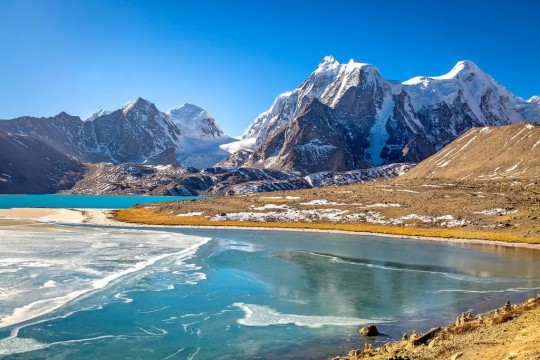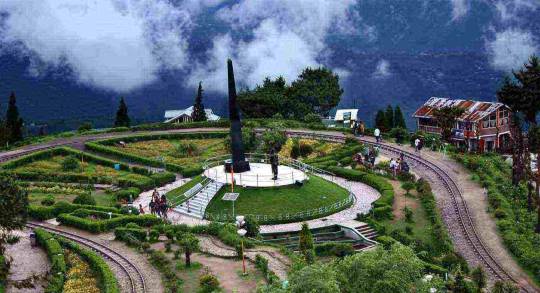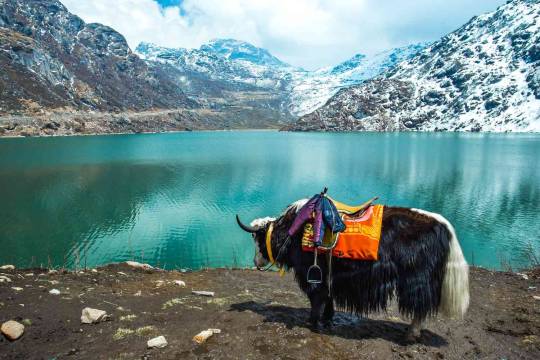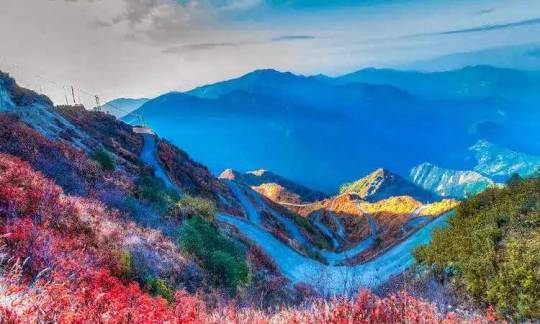#Northeast tour package
Text
0 notes
Text
Himalayan Mountaineering Institute | DARJEELING
Himalayan Mountaineering Institute is a prime place where the training for climbing several peaks of the world is mentored. This proud institute stands aloof than all and is a must visit place in Darjeeling where one can gain a lot of knowledge, enjoy various activities and witness an inspiring arena.
This institute was established in order to commemorate the successful ascent of Mount Everest by Mr. Tenzin Norgay Sherpa in the year 1953 accompanied with Sir Edmund Hillary. The foundation stone of HMI was laid by the first Prime Minister of India, Pandit Jawaharlal Nehru on 4th November, 1954. This institute was constructed with a mission to encourage the mountain climbers and teach them the skills required for the same. Being the bestmountaineering institute of South East Asia, it is also known as ‘Mecca of Indian Mountaineering’.Mr. Tenzin Norgay Sherpa was the first director of Field Training in HMI.At present HMI conducts a variety of mountaineering and adventure courses which are rigorous and provides the trainees an opportunity for developing their skills in mountain climbing and has a vision to cultivate a spirit of adventure in each student.All the courses are designed to instill the sagacity of amity, discipline, selflessness and concern for environment protection.read more

#darjeeling#trekking#queenofhills#hmi darjeeling#beautiful places#incredibleindia#hill stations#india tourism#northeast india#tourism#travelblogger#travel destinations#amazing places#darjeeling tour package#tenzing sherpa#travel blogs#travel#darjeeling tea#toy train#the darjeeling limited
3 notes
·
View notes
Text
Explore Nature's Wonderland: Kaziranga Tour Package Unveiled for Adventure Seekers
Embark on a thrilling adventure with our Kaziranga tour package, immersing yourself in the wonders of nature and wildlife in this picturesque wilderness
https://www.hillrovers.com/post/kaziranga-and-meghalaya-4-nights-5-days
0 notes
Text
Which State Is Best For Tourism In Northeast India?
Northeast India is an extended arm of India that is filled with scenic spots, gorgeous valleys and beautiful landscapes. Rich in cultural heritage, hospitality, biodiversity, dense jungles and caves, exotic flora and fauna, the northeast region is nature’s aesthetic creation straight out of a dream.
0 notes
Text
India is home to some of the world's most beautiful hill stations. Of these, the hill stations in Northeast India offer a glimpse of nature in its purest and most pristine form. The snow-clad mountains covered with a thick carpet of lush greenery and embellished with dense forests provide the perfect retreat into nature's mysterious beauty.
0 notes
Text
Embrace the Magic of Darjeeling
Darjeeling is more than a destination; it's an experience that resonates with your soul. Whether you're captivated by the mountains, engrossed in the tea-making process, or immersed in the cultural tapestry, every moment in Darjeeling is a symphony of nature's beauty and human heritage.
Embark on a Journey to Darjeeling: A Harmony of Nature, Culture, and Tranquility Awaits.
0 notes
Text
North East – The Unexplored Family Tour
While you're here, you might get a better understanding of what it's like to live in the foothills of the Himalayas and watch the dawn over some of the highest mountains and deepest valleys in the world. While you're here, you'll be able to witness the sunrise over some of the highest mountains and deepest valleys in the world. You might learn something useful from going through this experience. If you have a strong desire to get away from the hustle and bustle of the city, you should give some serious thought to the possibility of moving to the serene hills instead. This is the best option for people who have this kind of desire. If you are going to be in the area of the country that is found to the northeast of the country, it is highly recommended that you pay a visit to the tea estates that are located in Darjeeling. When you get the opportunity to do so, you should definitely seize the chance to indulge in some traditional momos and Darjeeling tea while you are in this area.
Must See: Tsomgo Lake to see the Red Panda, migratory ducks, and other species of flora and wildlife; Yumthang Valley for its breathtaking panoramic magnificence; Rumtek Monastery for its one-of-a-kind religious art artifacts; Darjeeling for its toy train ride and its real tea flavors.
Please don't hesitate to get in contact with one of our experienced Trip Counselors if you have any questions about the educational and cost-effective Northeast trips we provide.

#north east india tour#north east tour packages#northeast tour#north east trip#north east india tour packages#north east package#north east india trip#north east trip packages#north east travel package#5 days trip to north east india#north east tour package from delhi#north east holiday packages#north east tour packages 15 days#north east family tour packages#north east tour package from kolkata#north east tours and travels#north east tour packages from guwahati#north east trip from delhi#northeast india tour#best north east tour packages#budget trip to north east india#Trip Counselors#trip planner#tour planner#solo trip#tour and travel#best trip#trip and tour
0 notes
Text
issuu
#Himachal Honeymoon Tour Packages#Himachal Honeymoon#Tour Packages of Himachal#Best Andaman Nicobar family holiday Packages#North East Tour Packages#Book Northeast India Tours
1 note
·
View note
Text
North East India Tour Packages at Budget Price | Himalayan Route

The perfect way to explore the beauty of this part is north east India tour packages at budget price by Himalayan Route. Avail best offers on Book customized North East packages & explore the dreamy land like never before.This taste can come in the form of budget trekking trips, or luxury resort experiences.
For more info please visit us at:
https://www.himalayanroute.com/domestic/northeast-tour-packages/
0 notes
Text
Best Meghalaya Tour Package in 2022
Meghalaya Tourism
There are 32.10 lac people living in the northeastern Indian state of Meghalaya. Megh, which means cloud, and aalay, which means home, are the two terms that gave rise to the name Meghalaya. The lengthy definition of Meghalaya is The Home of the Clouds.
Contact us to visit Meghalaya..

Meghalaya spans 22430 square kilometres. The Meghalaya state capital is Shillong. Meghalaya was a part of Assam state till 1972. This area was referred to by former British commanders as "Scotland of the East."
0 notes
Link




This is best suited tour package for people looking long Sikkim tour package, this package cover tour of most of the famous places of Sikkim starting with capital city Gangtok tour, than go for Lachung tour, Yumthang Valley Sikkim tour, Pelling tourism tour, during the tour you find that the tag line of Sikkim tourism see more at: https://bit.ly/3LhNyIH
#Sikkim tour package#Darjeeling tour package#gangtok tour package#travel agent in delhi#travel agents in delhi#tour operator in delhi#travel agency in delhi#travel agency in india#golden triangle package
3 notes
·
View notes
Text
MALL ROAD,DARJEELING
Chowrasta is the heart of Darjeeling. It is the central meeting point of four roads. It is a beautiful esplanade where one can enjoy the sips of tea and beautiful scenery of awestricken tourists.
READMORE

#travel#queenofhills#darjeeling#darjeeling tour package#hill stations#beautiful places#incredibleindia#travel blogs#nature hikes#nature#mountains#landscapes#trees#nature photography#awesome places#awesome#morning walk#northeast india#india
0 notes
Text
Infinite Elegance: Unwind with a Luxury Tour in Northeast India
Embark on a journey of opulence in Northeast India. Our luxury tour package offers unparalleled elegance, curated experiences, and serene retreats for an unforgettable and indulgent escape.
https://www.hillrovers.com/post/explore-the-uncharted-beauty-of-northeast-india-with-hill-rovers-exquisite-travel-packages
0 notes
Photo


Two Solar Eclipses Are Coming to America The countdown has begun! Exactly one year from today, the first of two major solar eclipses just six months apart will occur over the Americas. On 14 October 2023, the Moon will pass directly between Earth and the Sun but will cover only 90% of the brilliant solar disk. The remaining 10% will appear as a blazing “ring of fire” around the Moon’s dark silhouette. This annular (Latin for ring-shaped) solar eclipse will be visible within a roughly 125-mile-wide path from Oregon to Texas and on into Mexico, Central America, and northern South America. Outside this path, nearly everyone in North America will have a partial solar eclipse. Then, on 8 April 2024, we’ll have a total solar eclipse like the one that crossed the U.S. from coast to coast on 21 August 2017. As it did that day, the Moon will fully block the Sun’s bright face, turning day into night for several minutes and revealing the magnificent solar corona, our star’s wispy outer atmosphere. This time the Moon’s shadow, about 115 miles wide, will cross Mexico, sweep northeast from Texas to Maine, and then darken the Canadian Maritimes. Most of the rest of North America will have another partial solar eclipse. Where and How to See Them Safely From beginning to end, a solar eclipse lasts up to about 3 hours. For most of that time, the Moon slowly covers the Sun, then uncovers it, and the eclipse is partial. The real excitement comes in the middle, but only for those within the narrow path of the Moon’s shadow. In April 2024 the Moon’s shadow will pass over more big cities than in 2017 and give at least 30 million Americans a shot at seeing the solar corona without having to travel. But there’s a catch: in early April much of the country is still in winter’s grip. Clear skies are most likely across Mexico and Texas Hill Country, so those are the places where many ardent eclipse enthusiasts plan to go. Weather prospects for the October 2023 annular eclipse look most promising in parts of Utah, New Mexico, and Texas. Sky & Telescope offers package tours to the best places to see both eclipses (skyandtelescope.org/tours). During partial and annular solar eclipses, the Sun remains dangerously bright at all times and must never be viewed directly except through special-purpose “eclipse glasses” or handheld viewers that comply with the ISO 12312-2 international standard. See eclipse.aas.org/safety for advice on where to get safe solar filters and on indirect viewing methods. During the brief total phase of a total solar eclipse, you can safely view the eclipsed Sun without eye protection. “If you can get yourself into the path of the Moon’s shadow for a total eclipse, it’s definitely worth the effort,” says Rick Fienberg, Project Manager of the American Astronomical Society’s Solar Eclipse Task Force. “A 99% partial solar eclipse doesn’t get you 99% of the experience of a total solar eclipse — that last 1% is literally the difference between night and day. As the Moon covers the last 1% of the Sun over the course of a minute or so, daylight fades by 10,000 times. And the solar corona is one of the most glorious sights in all of nature!” For the annular eclipse in 2023, observers under clear skies within the path of the Moon’s shadow from Oregon to Texas will see the “ring of fire” for up to 5 minutes. For the total eclipse six months later, totality — when the Moon fully obscures the Sun, the temperature drops, bright stars and planets dot the daytime sky, and sunrise/sunset colors ring the horizon — lasts nearly 4 minutes 30 seconds at the U.S. border with Mexico and about 3 minutes 20 seconds at the border with Canada. Another total solar eclipse won’t cross the U.S. until August 12, 2045, so the April 2024 event is your best chance to catch totality for a generation. Getting Organized The AAS Solar Eclipse Task Force, which is helping to coordinate nationwide planning, is hosting a hybrid (in-person + virtual) solar eclipse planning workshop Friday-Saturday, 21-22 October 2022, at the Rochester Museum & Science Center (RMSC), 657 East Ave., Rochester, NY 14607 (eclipse.aas.org/workshops/oct2022). The theme is “Preparing Your Community for the Coming Solar Eclipses.” The workshop is for everyone involved (or wanting to become involved) in preparing their community for the upcoming North American solar eclipses, whether on or off the eclipse path(s). Attending will be more than 150 amateur and professional astronomers; formal and informal educators; local, state, and national government officials; representatives from the tourism and hospitality industries; professionals in health, safety, transportation, and emergency management; local, state, and national park rangers; and artists, filmmakers, science writers, and event planners. Eclipse Geometry We get solar eclipses because, by a remarkable cosmic coincidence, the Sun and Moon appear almost exactly the same size in our sky. The Sun’s diameter is really about 400 times bigger than the Moon’s, but the Sun is also about 400 times farther away. Because Earth’s orbit around the Sun and the Moon’s orbit around Earth are both ellipses, not perfect circles, the apparent sizes of the Sun and Moon vary a little during the year (Sun) and during each month (Moon). Our planet is closest to the Sun (perihelion) in early January and farthest (aphelion) in early July, and the Sun appears about 3% wider in January than in July — not that you’d notice. When the Moon is closest to Earth (perigee), its apparent diameter is about 11% larger than when it’s farthest (apogee); again, this effect is not too noticeable. When near perigee, the Moon can easily cover the entire solar disk and unveil the ethereal corona. But near apogee the Moon is too small to fully cover the Sun’s face, so at mideclipse a brilliant annulus (ring) of sunlight encircles the lunar silhouette. You might wonder why we don’t have a solar eclipse at every new Moon. It’s because the Moon’s orbit around Earth is tipped about 5 degrees to Earth’s orbit around the Sun (which, from our perspective, is the Sun’s annual path through the zodiacal constellations). At new Moon, our natural satellite usually passes above or below the Sun. But twice each year, currently in April and October, the new Moon does pass in front of the Sun, so we get solar eclipses. Whether they’re partial, annular, or total depends on how precisely the Sun, Moon, and Earth align and on the distances from Earth to the Sun and Moon.
9 notes
·
View notes